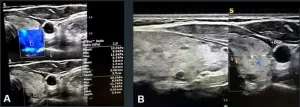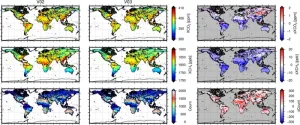(Press-News.org) COLUMBUS, Ohio – Having a four-year college degree and a low level of stress are strongly linked to psychological resilience in American women aged 80 and older, a new study suggests.
Researchers analyzed data from the Women’s Health Initiative to identify factors that are associated with higher self-rated resilience – the ability to weather storms and rebound from setbacks – among almost 30,000 women with an average age of 84.
Other characteristics linked to higher resilience included stronger social support, higher self-rated health and a lower risk of depression than levels among women who reported lower resilience, results showed.
The findings point to interventions health practitioners could adopt to improve the quality of life for older women in their care, said lead author Jessica Krok-Schoen, assistant professor in health sciences in the School of Health and Rehabilitation Sciences at The Ohio State University.
“Yes, people are living longer, and that’s great in terms of chronological age, but then there is the question: How are they doing?” Krok-Schoen said. “I think we often put older adults away in our minds and assume they’re living in institutional settings, but 90% are aging in place – so what are some ways that we can connect and support older women who have a lot of life to share and who make many contributions to our society?”
The study was published recently in the Journals of Gerontology Series B.
The sample of 29,347 women was 91.4% white, 3.7% Black, 1.9% Hispanic and 1.7% Asian. Researchers set out to determine how race, ethnicity and neighborhood socioeconomic status affected resilience in women 80 and older, but found that many factors most strongly associated with a high level of resilience did not differ based on the women’s race or ethnicity.
The analysis did find a difference in resilience scores based on neighborhood socioeconomic status, with lower neighborhood socioeconomic status correlating with lower resilience scores. Almost half of the participants lived in an area with moderate socioeconomic status.
Resilience was measured based on participants’ level of agreement or disagreement with three statements: “I tend to bounce back quickly after hard times,” “It does not take me long to recover from a stressful event” and “I have a hard time making it through stressful events.”
The analysis looked for associations between resilience scores and numerous variables that included demographic data, depression and stress, independent engagement in daily living activities, spirituality, social support, significant life events, major illnesses, and lifestyle and diet assessments.
The overall average resilience score was 3.96 out of 5. Though associations between resilience level and many variables were found, there were clear standouts, Krok-Schoen said.
Higher education and lower perceived stress were consistently linked to higher resilience among the women across race, ethnicity and socioeconomic groups. On the other end of the spectrum, increased likelihood of depression was significantly linked to lower resilience for most older women.
Higher social support also rose to the top of the factors closely linked with higher resilience for most women.
“This is about having people around you, but it’s not just the number – this involved a measure of the quality of relationships,” Krok-Schoen said.
Higher self-rated health and fewer physical symptoms were also major correlates with higher resilience.
Krok-Schoen noted that the analysis captured data at a single point in time, so there is a chicken-or-egg situation at play: Do these older women feel less stressed, depressed or burdened by ailments as a function of their resilience, or does lower stress, depression and physical pain contribute to a stronger sense of being resilient?
A few factors consistently linked to higher resilience were found only among the women living in moderate neighborhood socioeconomic conditions. These included living alone and spirituality.
One characteristic showing no correlation with resilience was having experienced significant life events, such as deaths of loved ones, major accidents or disasters, physical and verbal abuse, or job losses.
“We thought there would be something there: either a high number of experiences would be linked to low resilience, or that women who had been knocked down by life would say, ‘I’m still here, I’m still kicking it,’” Krok-Schoen said. “It would be interesting to take a look at this among younger populations – is ‘time heals all wounds’ operationalized here?”
She also said resilience is not something we either have or we don’t, but that it is a process related to adapting, and it fluctuates.
By understanding what older women say about their own resilience, Krok-Schoen said, experts could develop interventions for this population designed to foster social support, manage stress, reduce depressive symptoms and encourage physical activity.
“As we age, all of these deficits are accumulating, but at the same time you have this wealth of experience,” she said. “Older adults are faring pretty well, but these data show us the main factors that support psychological resilience among this group. Let’s see if we can make improvements.”
The Women’s Health Initiative is funded by the National Heart, Lung, and Blood Institute.
Ohio State co-authors of the study included Michelle Naughton, Ashley Felix, Mengda Yu, Eric McLaughlin, Timiya Nolan and Rebecca Jackson (now deceased).
#
Contact: Jessica Krok-Schoen, Jessica.Krok@osumc.edu
Written by Emily Caldwell, Caldwell.151@osu.edu; 614-292-8152
END
UC Riverside scientists are taking a modern approach to studying a murky subject — the quantity, quality, and sources of microplastics in Los Angeles County’s urban streams.
Microplastics are particles with a maximum diameter of 5 millimeters, roughly the size of a pencil eraser. The category can include nanoplastics, which are far smaller than the width of an average human hair.
Scientists have been aware that these particles have been filtering through the environment for decades, but concern about them has only started to ramp up more recently.
“There is mounting evidence that these materials are toxic,” said Andrew Gray, UCR assistant professor of ...
PULLMAN, Wash. -- A viable formula for a carbon-negative, environmentally friendly concrete that is nearly as strong as regular concrete has been developed at Washington State University.
In a proof-of-concept work, the researchers infused regular cement with environmentally friendly biochar, a type of charcoal made from organic waste, that had been strengthened beforehand with concrete wastewater. The biochar was able to suck up to 23% of its weight in carbon dioxide from the air while still reaching a strength comparable to ordinary cement.
The research could significantly reduce carbon emissions of the concrete industry, which is one ...
Barcelona, Spain – 18 April 2023: A score based on four readily available clinical and imaging parameters identifies the heart failure patients who benefit most from atrial fibrillation ablation, according to late breaking science presented at EHRA 2023, a scientific congress of the European Society of Cardiology (ESC).1
Atrial fibrillation and heart failure often coexist.2 It is estimated that approximately 30% of patients with heart failure will develop atrial fibrillation and patients with atrial fibrillation have a five-fold increased risk of developing heart failure.3 Each condition aggravates the prognosis of the other. Atrial fibrillation patients who develop ...
Responding to the increasing demand for sustainable energy research, IOP Publishing is launching a new open access (OA) environmental research journal. Environmental Research: Energy (EREN) will openly publish the latest findings around clean and sustainable energy for all. Aligned with a number of the UN’s Sustainable Development Goals (SDGs), the journal launch comes at a time when research output around renewable energy and sustainability has seen a 600% increase compared to ten years ago.
Environmental Research: Energy is the latest addition to IOP Publishing's expanding Environmental Research ...
Barcelona, Spain – 18 April 2023: An innovative three-step ablation approach including ethanol infusion of the vein of Marshall improves freedom from arrhythmias in patients with persistent atrial fibrillation compared to pulmonary vein isolation (PVI) alone, according to late breaking science presented at EHRA 2023, a scientific congress of the European Society of Cardiology (ESC).1 Preliminary results at 10 months are presented, with follow up ongoing until 12 months.
The cornerstone of catheter ablation of atrial fibrillation is complete isolation of the pulmonary veins.2 However, only 50–60% of patients remain in sinus rhythm at two years.3 Numerous ...
Barcelona, Spain – 18 April 2023: A novel software tool set to improve the management of elderly atrial fibrillation patients with multiple conditions is being designed by the EU-funded and ESC-coordinated EHRA-PATHS consortium. The latest updates on this clinical innovation will be presented at EHRA 2023, a scientific congress of the European Society of Cardiology (ESC).1
Scientific coordinator Professor Hein Heidbuchel said: “EHRA-PATHS is developing a standardised approach to ensure that patients with atrial fibrillation receive evidenced-based therapies for the comorbidities that underlie or complicate their heart rhythm disorder.”
Atrial ...
Honolulu, HI | April 18, 2023—Findings from an award-winning Scientific Online Poster presented during the 2023 ARRS Annual Meeting on the island of Oahu determined that assessing the vascularity and elastography in suspect TIRADS categories can efficiently diagnose malignancy of thyroid nodules.
Acknowledging that sonographic TIRADS scoring remains the first method of imaging assessment for diagnosing malignant thyroid nodules, “we assessed the added value of shear-wave elastography (SWE) to classic TIRADS assessment,” said Leila Aghaghazvini, MD, from the department of radiology at Shariati Hospital and Iran’s University ...
Honolulu, HI | April 18, 2023—The American Roentgen Ray Society (ARRS) is pleased to announce that The Roentgen Fund® 2023 Honorary Lecture, “Advanced High-Resolution CT (HRCT),” will be dedicated to W. Richard “Rick” Webb, MD—the late University of California, San Francisco (UCSF) radiologist who transformed the practice of thoracic imaging.
Exploring multiple conditions diagnosed via HRCT, as well as the radiologist’s role on today’s multidisciplinary teams, “Advanced HRCT” will take place on Tuesday, April 18, 2023, 1:00–2:20 PM local time, during the 2023 ARRS Annual Meeting in Honolulu, HI.
A high-profile presentation ...
1. Background and objectives
The Greenhouse gases Observing SATellite (GOSAT) that is the joint mission of the Ministry of Environment, the National Institute for Environmental Studies (NIES), and the Japan Aerospace Exploration Agency has observed almost continuously since its launch and is currently in operation.
Thermal And Near-infrared Sensor for carbon Observation – Fourier Transform Spectrometer (TANSO-FTS) onboard GOSAT observes the shortwave infrared (SWIR) spectra(*1). The carbon dioxide (CO2) and methane (CH4) concentrations can be estimated by ...
The time has come and gone for universal masking in healthcare settings, according to healthcare epidemiologists and infectious diseases experts from healthcare systems throughout Boston and beyond. In a commentary published in Annals of Internal Medicine and co-authored by experts from Mass General Brigham, Beth Israel Lahey Health, Tufts Medicine, the VA Healthcare System Boston, and other healthcare systems across the country, the authors describe the changing context and conditions of the pandemic and outline why universal masking should no longer be required in healthcare settings.
“While critically important in the earlier ...




